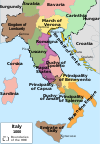The 660s decade ran from January 1, 660, to December 31, 669.
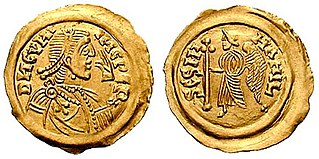
Year 688 (DCLXXXVIII) was a leap year starting on Wednesday of the Julian calendar. The denomination 688 for this year has been used since the early medieval period, when the Anno Domini calendar era became the prevalent method in Europe for naming years.
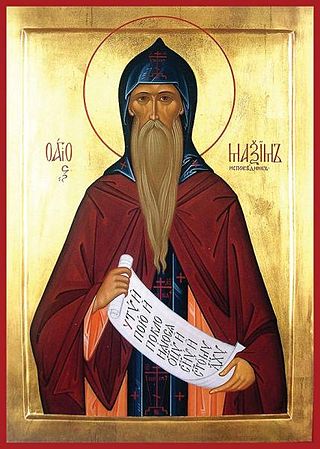
Year 662 (DCLXII) was a common year starting on Saturday of the Julian calendar. The denomination 662 for this year has been used since the early medieval period, when the Anno Domini calendar era became the prevalent method in Europe for naming years.

King of Italy was the title given to the ruler of the Kingdom of Italy after the fall of the Western Roman Empire. The first to take the title was Odoacer, a barbarian warlord, in the late 5th century, followed by the Ostrogothic kings up to the mid-6th century. With the Frankish conquest of Italy in the 8th century, the Carolingians assumed the title, which was maintained by subsequent Holy Roman Emperors throughout the Middle Ages. The last Emperor to claim the title was Charles V in the 16th century. During this period, the holders of the title were crowned with the Iron Crown of Lombardy.

The Duchy of Benevento was the southernmost Lombard duchy in the Italian Peninsula that was centered in Benevento, a city in Southern Italy. Lombard dukes ruled Benevento from 571 to 774, when the Kingdom of the Lombards was conquered by the Kingdom of the Franks. Being cut off from the rest of the Lombard possessions by the papal Duchy of Rome, Benevento always had held some degree of independence. Only during the reigns of Grimoald and the kings from Liutprand on was the duchy closely tied to the Kingdom of the Lombards. After the fall of the in 774, the duchy became the sole Lombard territory which continued to exist as a rump state, maintaining its de facto independence for nearly 300 years as the Principality of Benevento.

The Agilolfings were a noble family that ruled the Duchy of Bavaria on behalf of their Merovingian suzerains from about 550 until 788. A cadet branch of the Agilolfings also ruled the Kingdom of the Lombards intermittently from 616 to 712. They are mentioned as the leading dynasty in the Lex Baiuvariorum. Their Bavarian residence was at Regensburg.

Rothari, of the house of Arodus, was king of the Lombards from 636 to 652; previously he had been duke of Brescia. He succeeded Arioald, who was an Arian like himself, and was one of the most energetic of Lombard kings. Fredegar relates that at the beginning of his reign he put to death many insubordinate nobles, and that in his efforts for peace he maintained very strict discipline.

Aripert I was king of the Lombards (653–661) in Italy. He was the son of Gundoald, Duke of Asti, who had crossed the Alps from Bavaria with his sister Theodelinda. As a relative of the Bavarian ducal house, his was called the Bavarian Dynasty.
Godepert was king of the Lombards, eldest son and successor of Aripert I. He was an Arian who governed from the ancient capital, Pavia, while his brother, Perctarit, a Roman Catholic, governed from Milan. In a war with his brother, he beckoned Duke Grimoald I of Benevento, who assassinated him in his Pavian palace, the Reggia. Godepert's son Raginpert managed to escape and would later rule, but first, Grimoald would seize the throne. He was buried in the Basilica of Santissimo Salvatore in Pavia.

Cunipert was king of the Lombards from 688 to 700. He succeeded his father Perctarit, though he was associated with the throne from 680.

Grimoald or Grimwald (†671) was a 7th-century King of Italy, ruling as Duke of Benevento from 647 to 662, and then as King of the Lombards from 662 until his death in 671.
The Bavarian dynasty was those kings of the Lombards who were descended from Garibald I, the Agilolfing duke of Bavaria. They came to rule the Lombards through Garibald's daughter Theodelinda, who married the Lombard king Authari in 588. The Bavarians were really a branch of the Agilolfings, and were themselves two branches: the branch descended in the female line through Garibald's eldest child and daughter, Theodelinda, and the branch descended from Garibald's eldest son Gundoald. Of the first branch, only Adaloald, Theodelinda's son by her second husband, whom she had chosen to be king, Agilulf, reigned, though her son-in-law Arioald also ruled. Through Gundoald, six kings reigned in succession, broken only by the usurper Grimuald, who married Gundoald's granddaughter:
Garibald was the young son of Grimoald I of Benevento, king of the Lombards, and Theodota, daughter of Aripert I. After his father's death in 671, he reigned briefly for three months until the numerous adherents of Perctarit, his uncle, who had been exiled by Grimoald nine years earlier, besought their candidate to return and elected him, deposing the young king. He was the last Arian king in Europe.
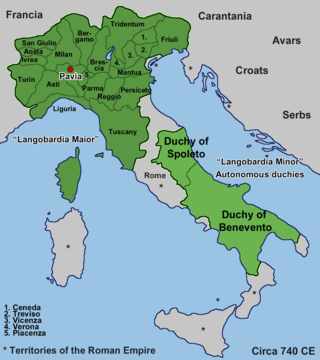
The Kingdom of the Lombards, also known as the Lombard Kingdom and later as the Kingdom of all Italy, was an early medieval state established by the Lombards, a Germanic people, on the Italian Peninsula in the latter part of the 6th century. The king was traditionally elected by the very highest-ranking aristocrats, the dukes, as several attempts to establish a hereditary dynasty failed. The kingdom was subdivided into a varying number of duchies, ruled by semi-autonomous dukes, which were in turn subdivided into gastaldates at the municipal level. The capital of the kingdom and the center of its political life was Pavia in the modern northern Italian region of Lombardy.

The Duchy of Friuli was a Lombard duchy in present-day Friuli, the first to be established after the conquest of the Italian peninsula in 568. It was one of the largest domains in Langobardia Major and an important buffer between the Lombard kingdom and the Slavs, Avars, and the Byzantine Empire. The original chief city in the province was Roman Aquileia, but the Lombard capital of Friuli was Forum Julii, modern Cividale.
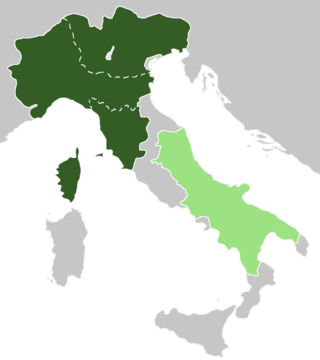
Austria was, according to the early medieval geographical classification, the eastern portion of Langobardia Major, the north-central part of the Lombard Kingdom, extended from the Adda to Friuli and opposite to Neustria. The partition had not only been territorial, but also implied significant cultural and political differences.
Rotarit was a Lombard duke, the last Duke of Bergamo.

The Basilica of Santissimo Salvatore is a Roman Catholic church in Pavia, region of Lombardy, Italy. It was founded in 657 by the Lombard king Aripert I and became a mausoleum for many of the Lombard kings.













